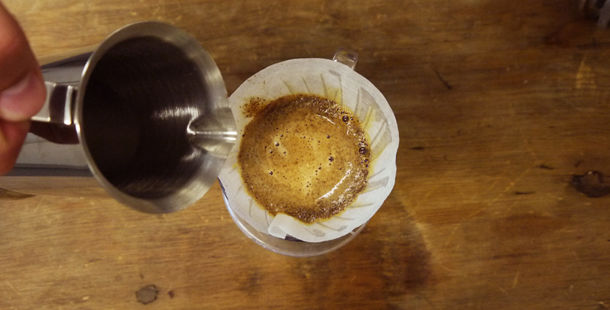By Merlin Jobst
I will admit, outright, before going forward that I have a bias when it comes to opinions regarding what constitutes a good cup of coffee. I grew up heavily associating the aroma of the drink with family, and filter coffee made in a cafetiere (otherwise known as a French press), drunk black and as strong and rich as liquorice was, for the most part, what my family drank. From the age when it was appropriate (and secretly a little while before) I began developing an attachment to utterly unadulterated coffee, and for most of my life I have accepted nothing but screaming hot black java as ‘proper’. Since living in London, however, I have begun considering the sheer scope of the coffee world. To write a column about the stuff I should experience and understand all aspects of it, and thankfully this exploration will provide me with a wealth of things about which to write. I’m wildly excited to start my caffeinated voyage of discovery, but for my first piece it seems appropriate to indulge myself and explain the differences between the two most common types of coffee, and demonstrate how a really great cup of drip-filter coffee can be made, using one of my favourite methods. The process is wonderfully precise, as is that of making a Turkish coffee, or a world-changing cocktail, or a really gorgeous, silky omelette. As with all of these, half-arsed methods are often favoured by the service industry for their ease or cost-effectiveness. Think about every cheap packaged sandwich you’ve eaten for lunch over the years, every awful plate of eggs you’ve eaten in cafes, and every mass-produced, over-carbonated glass of swill you’ve been presented in place of a good pint of beer. Then think on to every watery cup of coffee that’s made your heart sink and your lips curl – poor, carelessly-made coffee is as much of a plague to a beautiful thing as any other once-artisan consumable that the world has developed a thirst for, and integral to this plague has been the rise of the Americano.
Caffè Americano – a phrase that literally translates to American coffee – has a stranglehold on the served coffee industry, and it’s not something I’ve ever been thrilled about. There are some great stories about where the roots of the Americano lie, but for now all you need to know is that it’s made by lengthening espresso with water. For many – those with a love for the cappuccino, the latte, the flat white – it isn’t an issue; espresso serves as a fantastic base for these long drinks, and due to the richness of milk they’re generally robust enough to satisfy. For those who prefer not to consume their coffee diluted in a large quantity of milk, however, the Americano is, more often than not, merely a watery doppelgänger of the blissfully pure, full-bodied cup of heaven that is a straight-up cup of coffee.
In basic terms, an Americano is made up of one or more shots of espresso combined with a (usually) hefty amount of boiling water to produce a longer drink that may be sipped like a filter coffee, as opposed to a small shot that’s over in 20 seconds. This is more than understandable; if I’ve paid for a coffee I want a coffee that will at the very least last for longer than it took to order it. Whilst some artisanal cafes can do delightful things with the formula – often largely up to the blend of beans and the strength of the shot – the Americano is generally served for convenience, as it’s faster, easier and cheaper than filtering. A great deal of pressure forces the hot water through the espresso, which means it’s very quick, but also means that the meeting of water and coffee grounds is over before they’ve had time to really get to know each other. Alone, this is no problem (I’m a sucker for a really good espresso) but when it’s lengthened to become an Americano the hot water used has never been in contact with fresh grounds, which accounts for its weak body. You’ll often find that an Americano will be thin and uninspiring – largely because it is almost entirely plain water plunged into something strong, like the way in which a glass of cordial is made.
Filtered coffee, however, is not diluted; it is the end product of water passing slowly, without pressure, through more coarsely-ground coffee and, usually, a light paper filter to drip leisurely into a receptacle below. Freshly-brewed filter coffee – and fresh it absolutely has to be to be of optimum quality – offers body that the rushed brewing an Americano doesn’t. The time taken in brewing filter coffee is largely responsible for its depth of flavour; simply, the grounds spend more time with the water and develop a stronger relationship with it.
Of course, espresso itself, when the blend is good, can be gorgeous – the cafe cultures of Italy and France are proof of this – but thinning those rich, silky, crema-topped shots down has always felt like such an odd and unnecessary thing to do. It’s also worth noting that in the States, the drip-filter is commonplace, and it’s as much of an evil as its watery imitator. Large pots will be made and left on hotplates for hours, and it is due to this that some believe the Americano to be of higher quality – simply because it is much easier to find a freshly-made Americano than it is to find fresh filter coffee. Well, all coffee is less enjoyable when no longer fresh, and I believe that when fresh, good filter coffee is the worthier drink.
Both the Americano and the filtered coffee will have their champions, of course, and both, when done well, absolutely have a place in coffee culture today. However, the monopolising reign of the convenient, unlovingly-prepared Americano has led to a poor knowledge of and appreciation for drip-filtered coffee, with many – including those making the coffees themselves – not understanding why anybody would care enough to want the alternative. Countless times have I ordered filter coffee from cafes and either been told that it isn’t available or, worse, watched the barista make up an Americano – probably in the hope that I won’t know the difference.
As with so many specialist trades, however, the drip-filter has been making a quiet, calm comeback in certain cafes in London, the most prominent of which is the Monmouth Coffee company, whose understanding of their craft and aim to roast coffees daily has given them almost holy grail-status to their consumers. Monmouth’s pour-over method of preparing their filtered coffee is one of utmost care, which takes a significant length of time per cup. This is why you are more likely to see pigs fly before you see their shop in Borough Market without a line that stretches all the way down the street, but speak to anybody who’s experienced a real cup of Monmouth filter and I’m willing to bet they’ll tell you it’s worth the wait.
An individual cup of filtered coffee brewed using the pour-over method requires good, unblended (we’ll discuss why eventually) coffee grounds, a paper filter and a cup. You will also need a filter cone; these can be bought online, and are usually made of either plastic or porcelain. Hunting down a good-quality porcelain filter cone is a worthy pursuit, as they’re a good weight and are a very nice thing to own (you can buy these in many specialist coffee shops).
Nb. Personally – and here is where you will hear trained baristas sharpening their knives for me as they read – I’ve always judged the amounts for the pour-over method on a cup-by-cup basis. Measurement of the grounds and water is an exact science in specialist coffee shops and I wouldn’t claim to make even half as a good a cup as any of them (this is practically a hack-job in comparison), but for me, on my kitchen table, I’m happy to experiment and get a feel for how the ratios affect the end product.
1. Place the cone on top of the receptacle, and tuck the paper filter into the cone.
 2. Pass boiling water over the filter and allow it to drip through into the cup. This will remove any starchy taste and help the actual coffee drip through more easily. After this, discard the papery water into the sink and reposition the cone on top of the cup.
2. Pass boiling water over the filter and allow it to drip through into the cup. This will remove any starchy taste and help the actual coffee drip through more easily. After this, discard the papery water into the sink and reposition the cone on top of the cup.
3. If grinding your coffee freshly, which is ideal, grind your beans to a reasonably coarse consistency and pour into the paper filter.
4. Slowly and precisely pour a little (30ml or so) hot water over your grounds in a circular motion, starting in the centre and moving outwards. It is a great deal easier to pour from something with a spout – of course, there are specially-designed pouring jugs for this, but a teapot or lipped jug will do the trick too.

5. After a minute (the coffee has now ‘bloomed’), continue pouring hot water, equally carefully, over the wet grounds, again starting in the middle and circling outwards. Pour until the water feels like it’s enough to fill the cup below to a satisfactory level.

6. After a minute or two the drips from the cone into your cup will become very slow, and this indicates that the brewing is finished. Remove and bin the filter from the cone and enjoy one of the purest and most full-bodied coffees you will ever taste.

This is, as I said, not an exact or definitive guide to the pour-over method. For that, go to a cafe like Monmouth Coffee and see how they do it. Talk to the baristas, if you can, and ask about measurements and timings and which coffees they use and why, and about why they favour this method; it’s a wonderful thing to talk to someone who cares about. However, you can use this article as a guide and, if you’re anything like me, you’ll really enjoy being involved in every step of your cup and really getting in touch with and understanding what’s gone into it.























